Classic eggplant parmigiana, a traditional Italian dish, has been a favorite among food lovers worldwide for its delicious and comforting taste. This dish showcases the humble eggplant, transforming it into a mouthwatering medley of flavors and textures.
The combination of crispy fried eggplant slices, rich tomato sauce, and gooey mozzarella and parmesan cheese makes it a satisfying choice for both vegetarians and meat-lovers alike. It’s a true showcase of summer flavors!
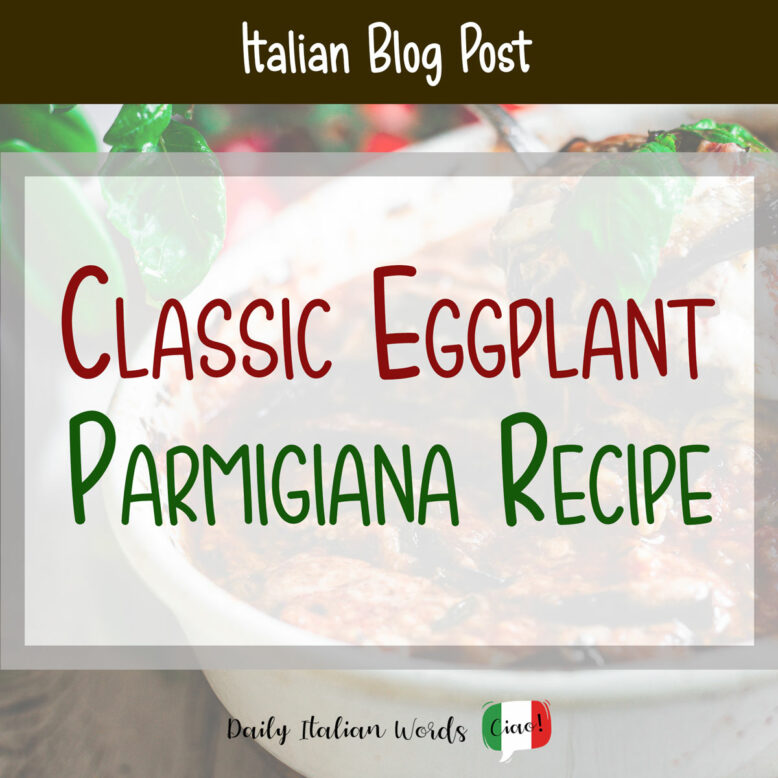
Preparing eggplant parmigiana involves a few key steps, such as salting and draining the eggplant to remove excess moisture, as well as layering the ingredients to create the perfect balance of flavors. A healthy amount of cheese and a flavorful tomato sauce complete this authentic Italian dish.

With its rich history and regional variations, this classic recipe offers an authentic taste of Italy in every bite. Inspired by Marcella Hazan’s classic preparation, there is none of the breading and deep-frying of the American-Italian eggplant parmesan.
In addition to being a delicious main course, Eggplant Parmiagiana is a versatile dish that can be served as an appetizer or side to complement other Italian favorites.
History of Eggplant Parmigiana
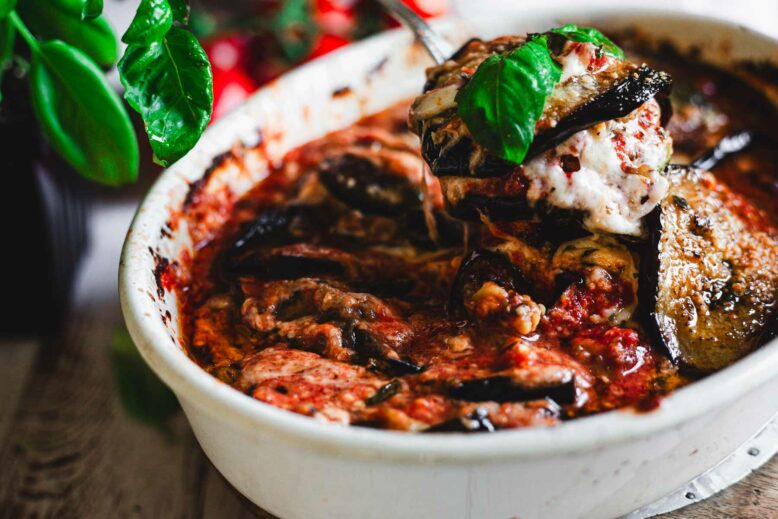
The origin of the classic eggplant parmigiana recipe is a subject of debate, with Sicily, Naples and Parma all claiming to have conceptualized this beloved dish.
Historically, the eggplant was introduced to Italy in the 7th century, when Arab merchants brought it from India. The versatile vegetable quickly became a staple in Southern Italian cuisine.
One of the earliest recorded recipes for eggplant parmigiana emerged in 1837 in a popular Neapolitan cookbook called Cucina Teorico-Pratica. This version introduced a tomato-based sauce layered with eggplant, establishing the foundation for the dish we know and love today.
Regardless of its precise origins, the popularity of eggplant parmigiana has grown over time, becoming a symbol of Italian culinary tradition.
Pronunciation

Eggplant Parmigiana, called “melanzane alla parmigiana“, “parmigiana di melanzane” or simply “parmigiana” in Italian, is a popular dish with several variations in its pronunciation. The Italian word for eggplant is melanzana.
To master the pronunciation of this classic dish, it is crucial to understand the syllables and focus on each part. Start with “melanzane,” pronounced as meh/lahn/DZAH/neh, followed by “alla,” pronounced as ahl/lah. And finally, “parmiagiana” is pronounced as pahr/mee/djah/nah.
What you need to make this dish
Cosa serve per preparare questo piatto

Eggplants – provide the hearty base for this dish, adding a meaty texture.
Melanzane – conferiscono a questo piatto una base solida, apportando una consistenza simile a quella della carne.
Salt – helps draw out excess moisture from the eggplant, ensuring a firmer result.
Sale – contribuisce a rimuovere l’umidità in eccesso dalle melanzane, migliorandone così la consistenza e rendendole più compatte.
Vegetable oil – used for frying the eggplant until golden brown, giving it a crispy exterior.
Olio vegetale – usato per friggere le melanzane fino a ottenere una superficie dorata e croccante.
Italian plum tomatoes – form the flavorful tomato sauce, adding a tangy contrast. You can use canned or ripe fresh tomatoes, but only when they’re perfectly in season.
Pomodori San Marzano – ideali per creare una salsa di pomodoro ricca e saporita, con un perfetto equilibrio di acidità. È possibile utilizzarli sia in scatola che freschi, ma si consiglia di optare per la versione fresca solo quando i pomodori sono in stagione.
Mozzarella cheese – creates a gooey and creamy layer, adding a delightful cheesy touch.
Mozzarella – aggiunge uno strato filante e cremoso al piatto, arricchendolo con un delizioso tocco di formaggio.
Fresh basil – infuses the dish with fresh herbal aromas, elevating the flavors. You can use dried basil, but the result will differ in its smell.
Basilico fresco – conferisce un aroma fresco ed erbaceo, arricchendo così la varietà dei sapori del piatto. Se scegli di usare il basilico secco, tieni presente che il risultato avrà un aroma leggermente diverso.
Dried oregano – adds a woodsy aroma to the dish. You can also use fresh oregano instead.
Origano secco – questo ingrediente aggiunge un aroma boscoso al piatto. Se preferisci, puoi usare anche origano fresco come alternativa.
Grated Parmigiano-Reggiano cheese – sprinkled on top for a nutty and savory finish.
Parmigiano Reggiano grattugiato – spolverato sul piatto prima di servirlo per un tocco finale gustoso che ricorda il sapore delle noci.
Directions
Istruzioni per la preparazione
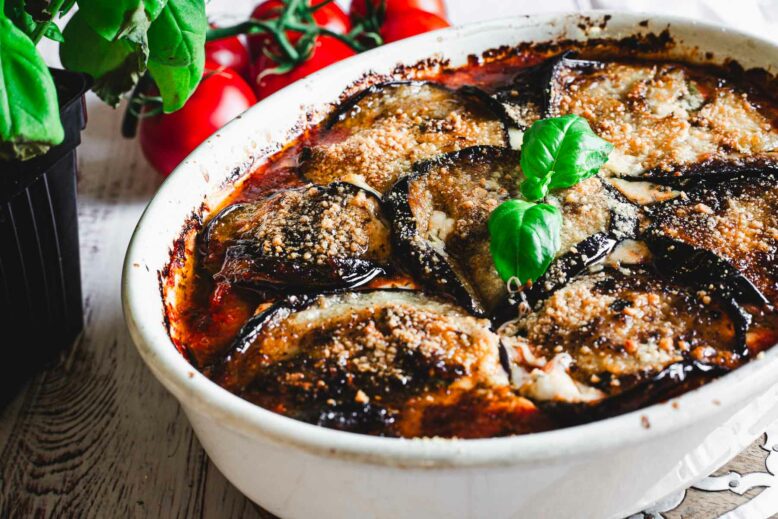
Preparing the Eggplant
Prepara le melanzane

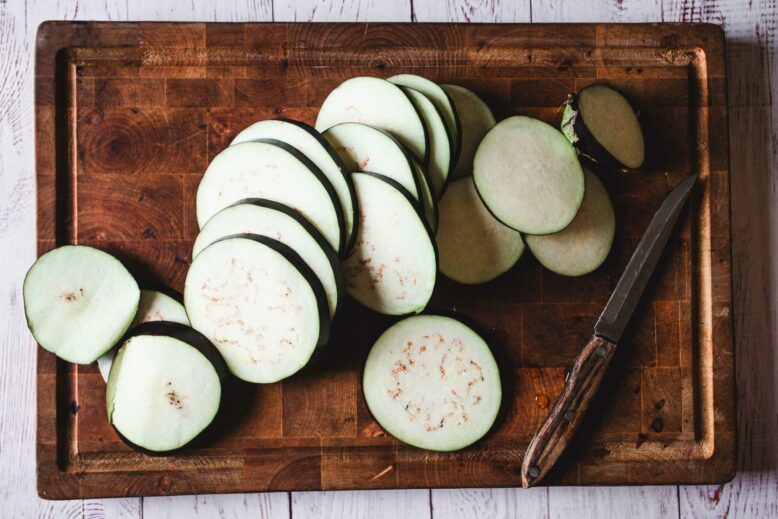
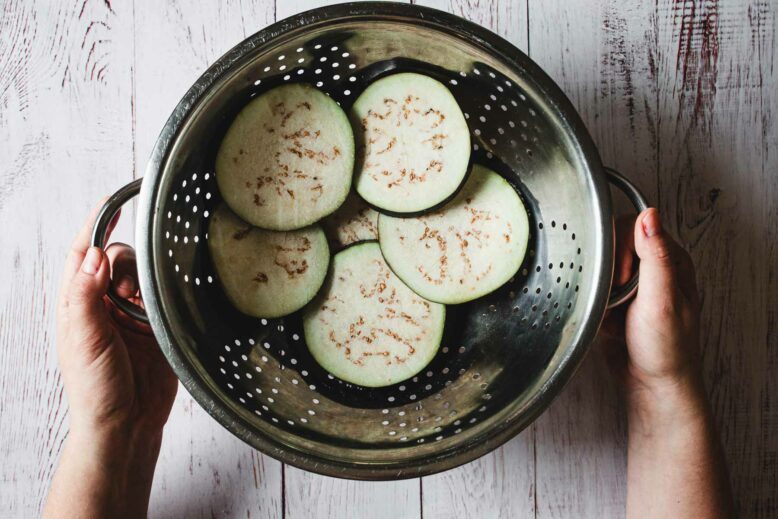
Start by choosing a nice, firm eggplant with a green “head.” Cut off the eggplant’s green top and slice it into ¼-inch thick strips. Some peel the eggplant; this is not necessary to do.
Scegli delle belle melanzane che siano sode al tatto e con una “testa” verde. Rimuovi la parte superiore verde delle melanzane e tagliale a fette dello spessore di circa 1/4 di pollice. Se preferisci, puoi pelarle, ma non è necessario.
Arrange the slices in a large colander and sprinkle eggplant with salt. Allow the eggplant to sit for 30 minutes to draw out excess moisture. Pat the slices dry with paper towels.
Disponi le fette di melanzana in uno scolapasta capiente e cospargile di sale. Lasciale riposare per circa 30 minuti per eliminare l’umidità in eccesso. Successivamente, asciuga le fette con della carta assorbente per rimuovere l’umidità residua.
Frying the Eggplant
Friggi le melanzane
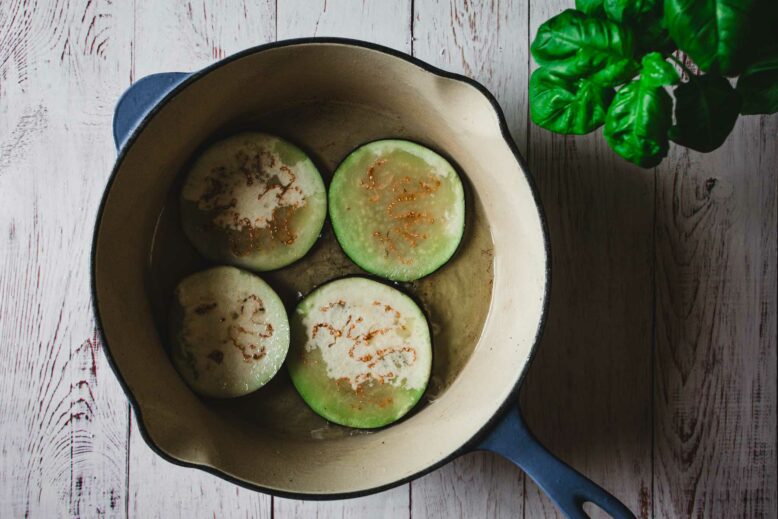
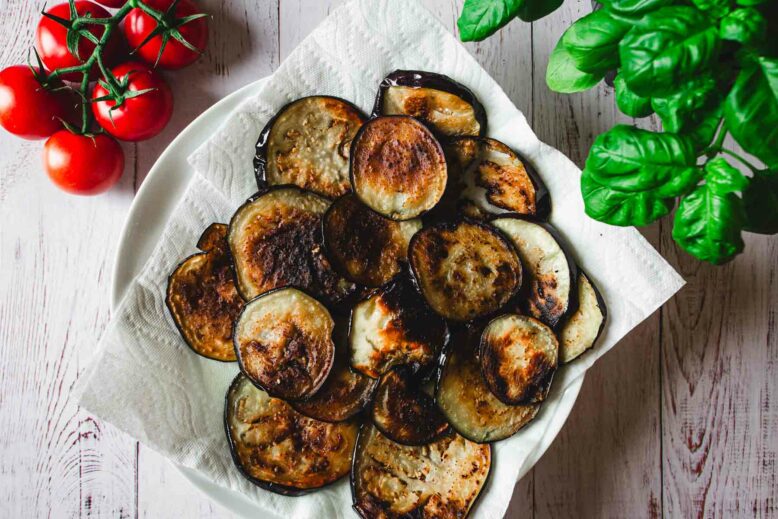
Heat vegetable oil in a large pan over medium heat. Working in batches, add the eggplant slices to the pan and fry until golden on both sides, about 1-2 minutes per side. Transfer the fried slices to a plate lined with paper towels to remove excess oil.
Riscalda dell’olio vegetale in una padella grande su fuoco medio. Friggi le fette di melanzana a piccoli gruppi fino a quando diventano dorate su entrambi i lati, circa 1-2 minuti per lato. Una volta pronte, trasferiscile su un piatto rivestito con carta assorbente per assorbire l’olio in eccesso.
Assembling and Baking the Eggplant Parmigiana
Assembla e cuoci la Parmigiana di melanzane
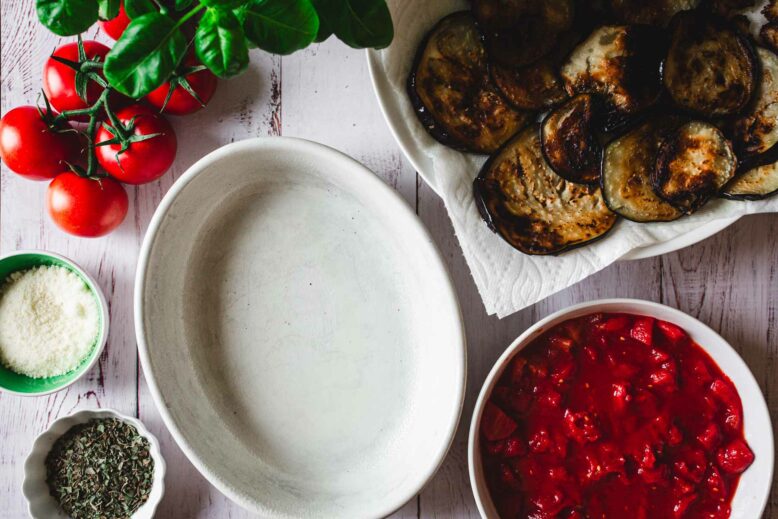
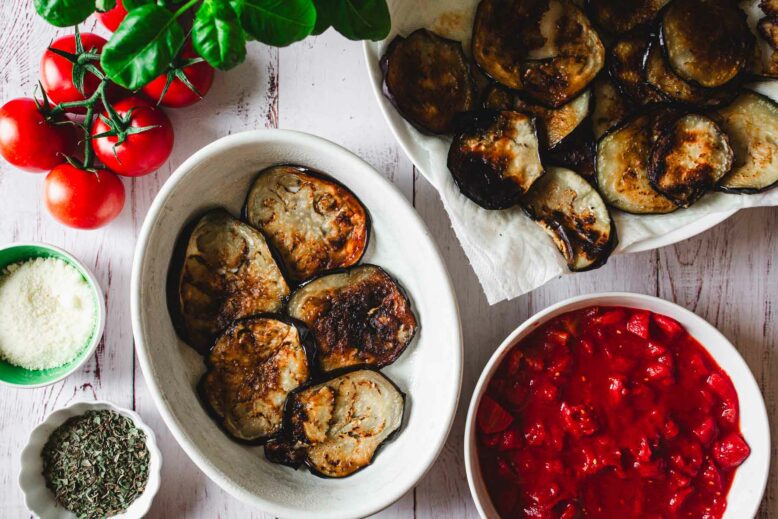
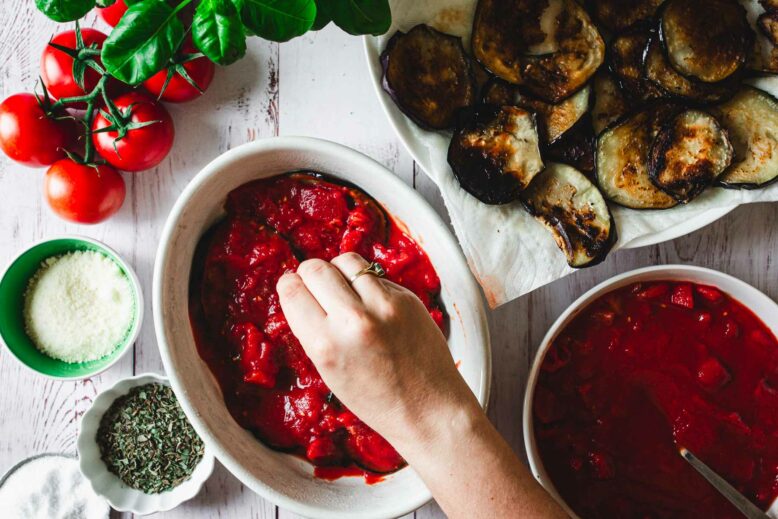
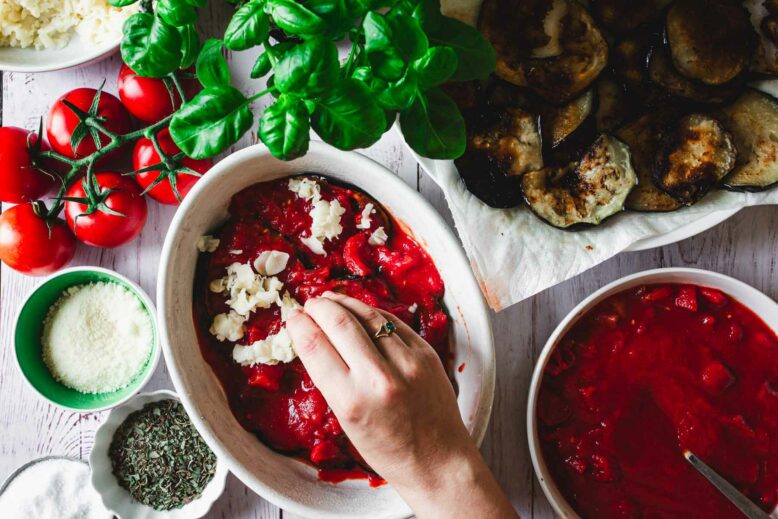
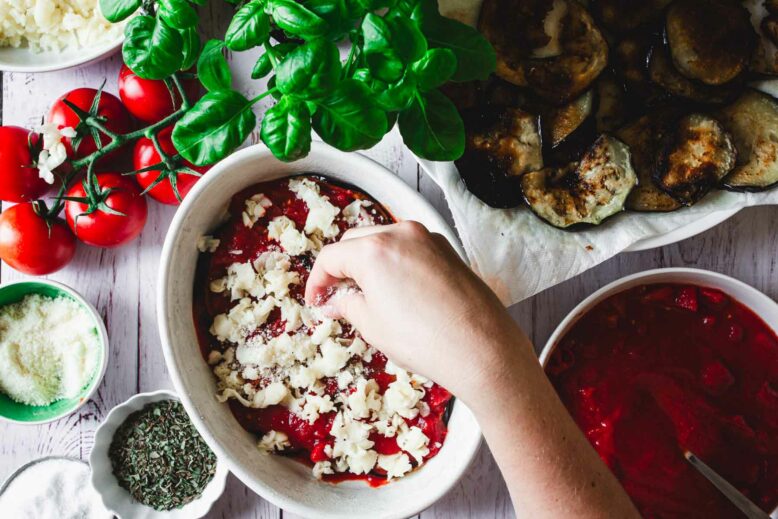
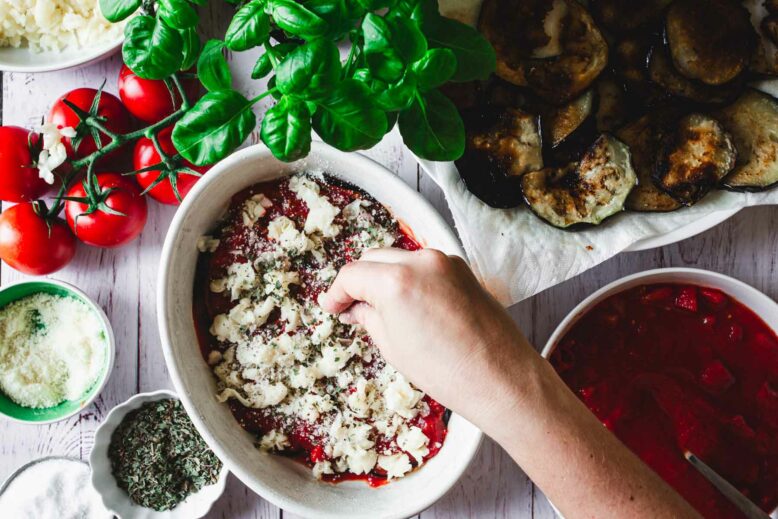
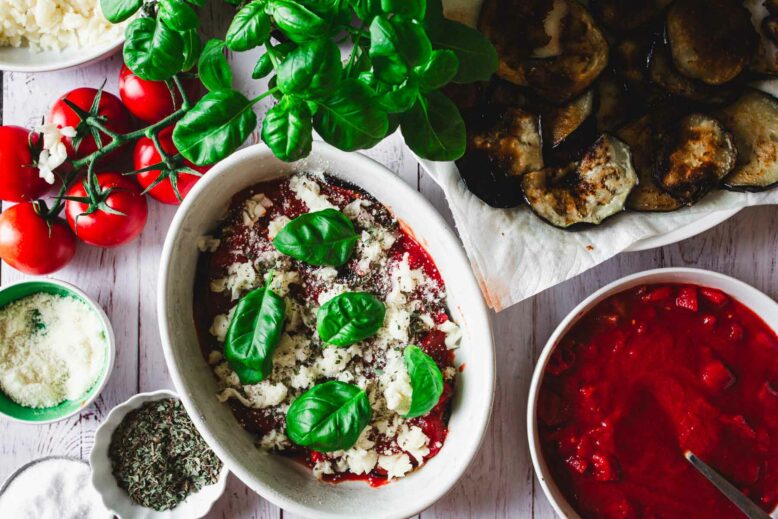
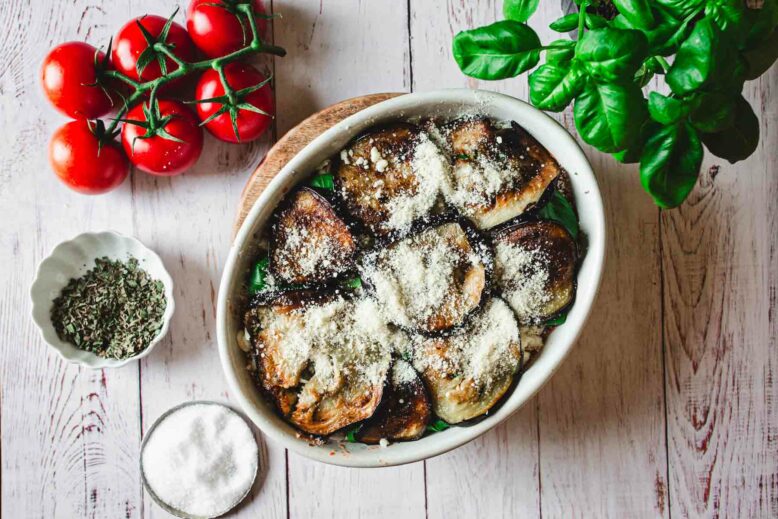

Preheat the oven to 400°F and prep a casserole dish with butter or cooking spray. Begin layering the dish by adding a thin layer of diced tomatoes to the bottom.
Preriscalda il forno a 200°C e ungi una teglia con burro o con uno spray antiaderente da cucina. Forma uno strato base di pomodori a cubetti sulla superficie della teglia.
Then, alternate between layering fried eggplant slices, tomatoes, mozzarella, basil, and Parmesan until all ingredients are used, finishing with a layer of eggplant on top. Sprinkle the remaining Parmesan over the dish.
Procedi poi alternando gli strati nel seguente ordine: fette di melanzane fritte, pomodori, mozzarella, basilico e Parmigiano. Ripeti gli strati fino all’esaurimento degli ingredienti, concludendo con un ultimo strato di melanzane fritte. Spolverizza con il Parmigiano rimasto.
Bake the eggplant Parmigiana in the upper third of the oven for 30-35 minutes, until the cheese is melted and the top layer is golden. Allow it to cool before serving.
Posiziona la teglia nella parte superiore del forno e cuoci per 30-35 minuti, o fino a quando il formaggio sia completamente fuso e la superficie si presenti dorata. Lascia raffreddare prima di servire.
Serving the Eggplant Parmigiana
Servi la Parmigiana
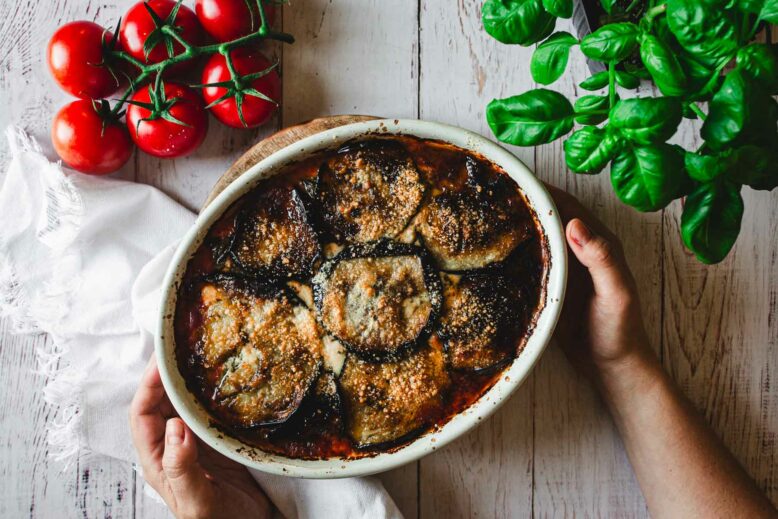
Once the Eggplant Parmigiana is out of the oven and has cooled slightly, it’s ready to be served. Cut it into generous portions and plate them beautifully.
Una volta raffreddata, la Parmigiana di Melanzane è pronta per essere servita. Tagliala in porzioni generose e disponile sui piatti in modo elegante.
For a finishing touch, add a sprinkle of freshly torn basil leaves on top for a burst of color and aroma.
Per un tocco finale di colore e sapore, guarnisci ogni porzione con alcune foglie di basilico fresco.
Pair this classic Italian dish with your choice of pasta, a side of Caprese salad or some crusty bread for a complete meal.
Per un pasto completo, puoi abbinare questo squisito piatto italiano a della pasta, un’insalata Caprese o del pane croccante.
Variations

Classic eggplant parmigiana can be adapted to suit different tastes and dietary preferences. Here are some favorites:
- One popular variation is to bake instead of fry the eggplant slices, resulting in a lighter, less oily dish. Baking the eggplant also allows you to use less oil, which reduces the overall calorie content.
- Another way to switch up the recipe is by using different vegetables instead of eggplant. For a unique twist, you could try making parmigiana with zucchini, artichokes, or even pumpkin slices.
- Consider experimenting with the cheeses used in the recipe. Traditional eggplant parmigiana uses mozzarella and Parmesan. You could substitute cheeses like provolone, fontina, or even ricotta to create distinct flavor profiles for this dish.
Top Tips
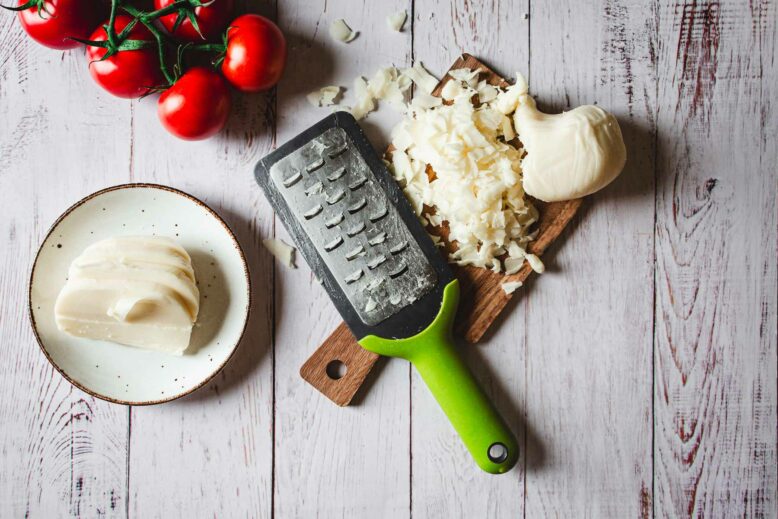
- When preparing a classic eggplant parmigiana, it’s essential to start by selecting fresh eggplants. Choose firm eggplants with smooth, shiny skin and without bruises or soft spots.
- Aim for uniform ¼-inch thick rounds to ensure even cooking and consistent texture throughout the dish.
- Salting the eggplant slices is a crucial step that helps to draw out excess moisture and prevent the dish from becoming soggy.
- When layering the casserole, start with a layer of marinara sauce at the bottom of the baking dish, followed by the eggplant slices, sauce, cheese, and fresh basil. Repeating this arrangement ensures all the layers cook evenly.
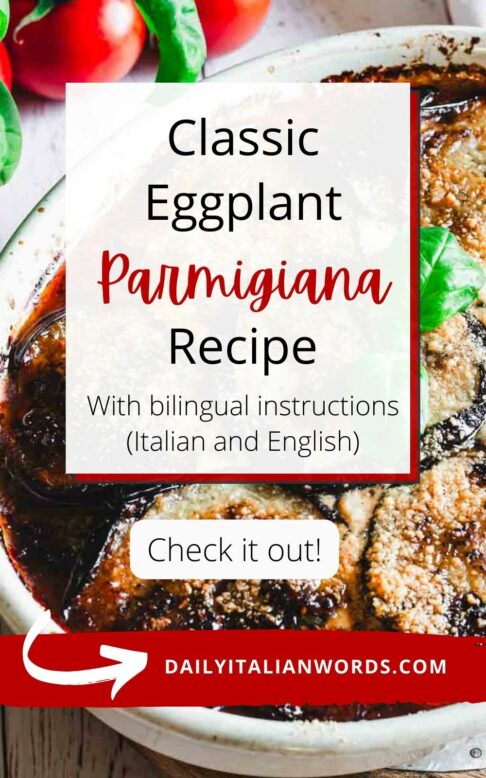
Frequently Asked Questions
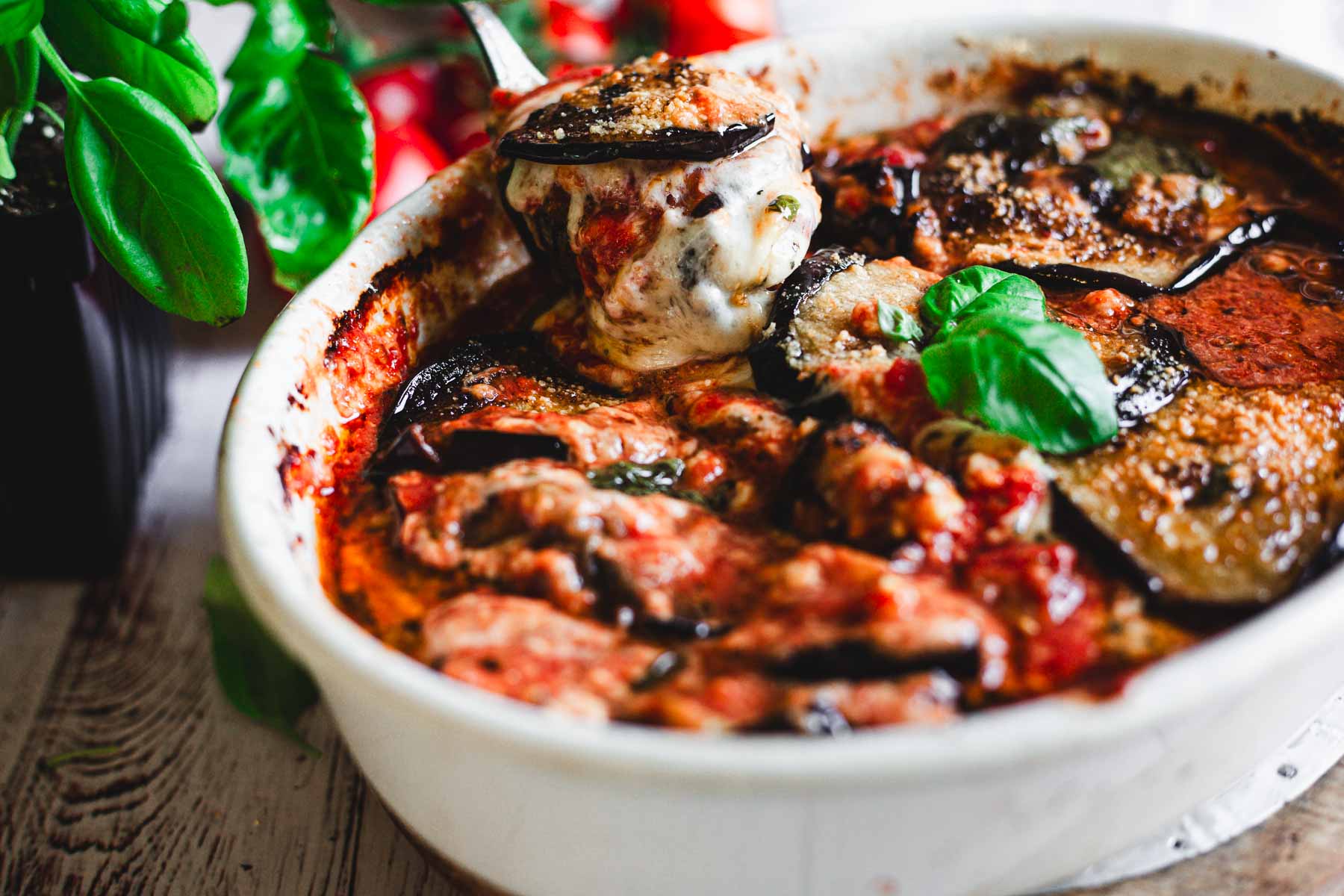
To prepare eggplant, it is essential to slice and salt the eggplants, then leave them in a colander to extract excess liquid for about 30 minutes. Afterward, pat dry the eggplant slices before frying them.
Eggplant can be either fried or baked for parmigiana. Both methods yield delicious results, but frying results in a crispier texture, while baking offers a lighter, healthier option.
For a healthier version, opt for baking the eggplant instead of frying. Preheat your oven to 400°F and lightly grease a baking sheet. Follow the same slicing and salting procedure, then bake on a sheet pan.
Eggplant parmigiana can be enjoyed with pasta, salad, or crusty bread. These accompaniments complement the rich flavors of the dish and provide a filling meal.
A classic eggplant parmigiana sauce consists of tomatoes, basil, and olive oil. Some variations also include adding onion.
To achieve a crispy texture, consider breading and frying the eggplant slices in hot oil before assembling the parmigiana. This method results in a deliciously crunchy exterior on the eggplant slices.
No, coating eggplants in breadcrumbs is not mandatory for making eggplant parmigiana. Baking or even frying the eggplant slices as they are is a healthier alternative that still results in a tasty dish.
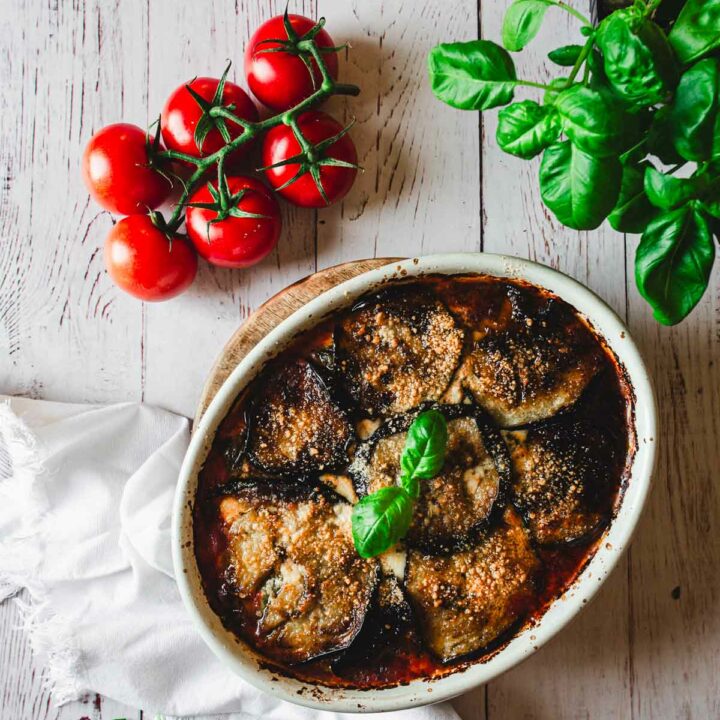
Easy Eggplant Parmigiana Recipe
A Classic Eggplant Parmigiana recipe where layers of fried eggplant are layered with tomato sauce, fresh basil, oregano, mozzarella, and parmesan to create a dish of rich flavors and culinary legacy.
Ingredients
- 2 large (3-pounds) eggplants
- Salt
- Vegetable oil
- 2 cups canned Italian plum tomatoes, well-drained
- and coarsely chopped
- 1 pound fresh mozzarella cheese, grated
- 8 to 10 fresh basil leaves
- ½ cup freshly grated Parmigiano-Reggiano cheese
- Butter, for greasing the dish
Instructions
- Cut off the eggplant green top. Slice into ¼-inch thick strips.
- Arrange eggplant slices in a large colander. Sprinkle salt on the slices and let sit for 30 mins. Pat dry with paper towels.
- Heat oil in a large pan on medium heat. Working in batches, add eggplants to the pan and fry until golden on both sides, about 1-2 minutes per side.
- Preheat the oven to 400°F. Spread a casserole dish with butter or cooking spray.
- Start by adding 1 tablespoon of tomatoes to the bottom of the dish. Working in the following order, layer fried eggplant slices, tomatoes, mozzarella, basil, and Parmesan in a buttered dish. Repeat layers, ending with eggplant slices on top. Sprinkle with remaining Parmesan.
- Bake in the upper third of the oven for 30-35 minutes, until the cheese has melted and the top layer is nice and golden.
- Let cool before serving. Top eggplant parmigiana with fresh basil right before serving. Buon Appetito!
.
Notes
Leftover eggplant parmigiana will keep in an airtight container in the refrigerator for 3-4 days.
.
Nutrition Information:
Yield: 6 servings Serving Size: 1 cupAmount Per Serving: Calories: 213Total Fat: 14.4gSaturated Fat: 5gCholesterol: 16mgSodium: 240mgCarbohydrates: 14.7gFiber: 7.1gSugar: 7.9gProtein: 9.9g
Ksenia Prints is a food blogger and photographer. She loves to create unique recipes and capture captivating images of homemade fresh food and products. I also thrive on bringing people together through food – in virtual workshops or in person.


